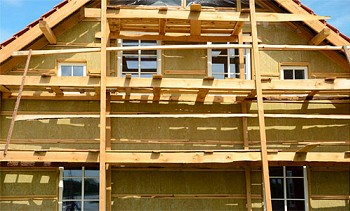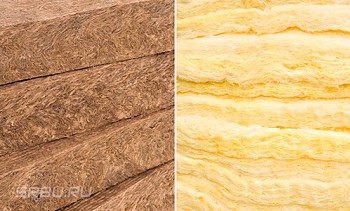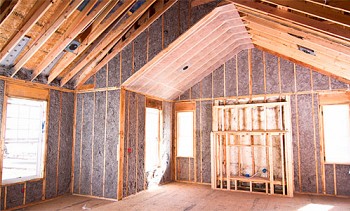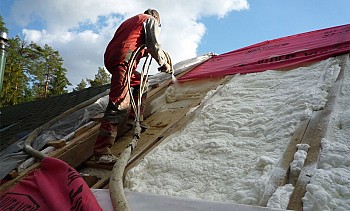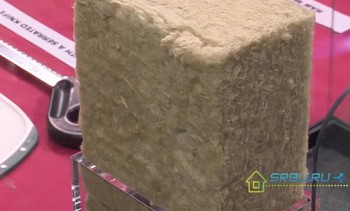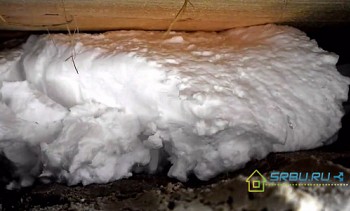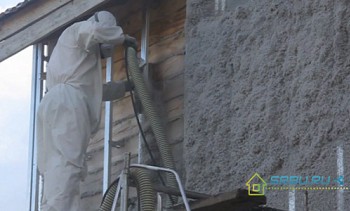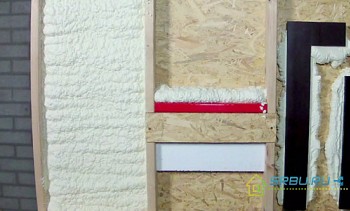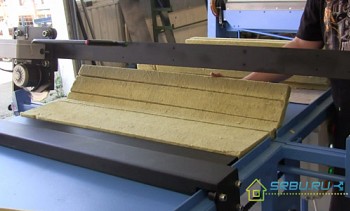Thermal insulation at any temperature will not hurt. If it is carried out correctly, then in the winter the rooms will become significantly warmer, and in the summer heat it will be cooler. Wall insulation will help create a comfortable microclimate both in the apartment and in the room for work. Manufacturers have tried and types of insulation today shine with diversity.
Arriving at the market or in the construction supermarket, one can only be surprised at the variety of heaters produced. They lie rolled up in bundles and bundles, poured into containers in the form of granules, powders and perlite sand, peeping with cotton from the packages. And they are also made in the form of a variety of cylinders, bricks, blocks and plates. What to choose? In principle, the main thing is not the form, but the content. More on this later.
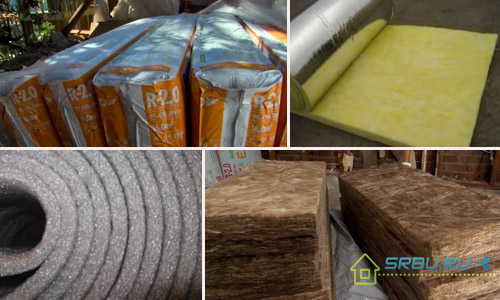
If you understand the characteristics of insulation materials, then you can easily choose the one you need. The main property of a heat insulator is its thermal conductivity. It shows how much heat can pass through a given material. There are two types of thermal insulation:
- Thermal insulation of the reflective type reduces heat consumption due to the fact that infrared radiation is reduced.
- Thermal insulation of the preventive type (it is used in most cases) involves the use of a heater with a low value of thermal conductivity. In this capacity, one of three types of materials can be used: inorganic, organic or mixed.
Preventive thermal insulation
Organic based heat insulators
Organic heaters are quite widely represented in the modern construction market. For their manufacture, raw materials of natural origin (agricultural and woodworking waste) are used. Also, some types of plastic and cement are part of organic heat insulators.
The resulting material has a high resistance to fire, does not get wet, does not react to biologically active substances. Apply it where the surface does not heat above 150 degrees. An organic heat insulator is often laid as the inner layer of a multilayer structure. This, for example, triple panels or plastered facades. Next, we consider what types of organic heaters are.
1. Arbolite insulation.
This rather new building material is produced from small sawdust, shavings, chopped straw or bulrushes. The base is added cement and chemical additives. These are calcium chloride, alumina sulfate and soluble glass. At the last stage of production, the products are treated with a mineralizer.
Characteristics of arbolite has the following:
- Density - from 500 to 700 kilograms per cubic meter.
- The coefficient of thermal conductivity is from 0.08 to 0.12 watts per meter per Kelvin.
- The compressive strength is from 0.5 to 3.5 megapascals.
- The bending strength is from 0.4 to 1 megapascal.
2. Foam polyvinyl chloride insulation.
PPVC consists of polyvinyl chloride resins, which after porosity acquire a special foamy structure. Since this material can be both hard and soft, it is a universal heat insulator. There are various types of insulation for walls, roofs, facades, floors and entrance doors made of PVC. The density (average value) of this material is 0.1 kilograms per cubic meter.
3. Chipboard insulation.
Particle boards basically have small shavings. It is nine tenths of the total volume of material.The rest is synthetic resins, an antiseptic substance, antiprene, water repellent.
Particleboard characteristics are as follows:
- Density - from 500 to 1000 kilograms per cubic meter.
- The tensile strength is from 0.2 to 0.5 megapascals.
- The bending strength is from 10 to 25 megapascals.
- Humidity - from 5 to 12 percent.
- Absorption of water by the material - from 5 to 30 percent.
4. Heater from DVIP.
The fiberboard insulation composition resembles chipboard. At the core are either wood waste or trimming stalks of straw and corn. It may even be old paper. Synthetic resins are used to bond the base. Additives are antiseptics, flame retardants and water-repellent substances.
The characteristics of the fiberboard are:
- Density - no more than 250 kilograms per cubic meter.
- The bending strength is not more than 12 megapascals.
- Thermal conductivity - up to 0.07 watts per meter per Kelvin.

Wood fiber insulation.
5. Polyurethane foam insulation.
Polyurethane foam is based on polyester, to which water, emulsifiers and diisocyanate are added. Under the influence of a catalyst, all these components enter a chemical reaction, forming a new substance. It has a good level of noise absorption, is chemically passive, not afraid of moisture. In addition, PPU is an excellent heat insulator. Since it is applied by spraying, it is possible to process the walls and ceiling of a complex configuration. However, cold bridges do not appear.
Characteristics of polyurethane foam:
- Density - from 40 to 80 kilograms per cubic meter. Upon reaching a density of 50 kilograms per cubic meter, the PUF becomes moisture resistant.
- The coefficient of thermal conductivity is from 0.019 to 0.028 watts per meter per Kelvin. This value is the best of all modern thermal insulation materials.

Application of polyurethane foam insulation on the surface of the walls.
- See the material >>Properties and characteristics of polyurethane foam its advantages and disadvantages
6. Mipora (penoizol).
If you beat the urea-formaldehyde resin, or rather, its aqueous emulsion, you get mipora. So that the material is not brittle, glycerin is put in the raw material. Sulfonic acids derived from petroleum are added to foam. And the catalyst that helps solidify the mass is organic acid. Mipora is sold both in the form of chips and in blocks. If it is supplied in liquid form, then it is poured into special cavities during construction. There, at room temperature, it becomes solid.
Characteristics of Mipora:
- Density - no more than 20 kilograms per cubic meter. Compared to cork, this figure is about 10 times less.
- The coefficient of thermal conductivity is about 0.03 watts per meter per Kelvin.
- The ignition temperature is more than 500 degrees. If the temperature is below this value, then this material does not burn, but only undergoes carbonization.
- The disadvantages of mipore are defenselessness against exposure to aggressive chemicals, as well as strong absorption of water.
- See the material >> Technical characteristics of penoizol, its properties and disadvantages as a heater
7. Styrofoam.
Expanded polystyrene, aka PPP, it’s also polystyrene, is 98 percent air. The remaining 2 percent is polystyrene, which is obtained from oil. There is also a small amount of modifiers in the polystyrene foam composition. In particular, these can be flame retardants.
PPP properties:
- The coefficient of thermal conductivity is from 0.037 to 0.042 watts per meter per Kelvin.
- Waterproofing qualities are high.
- Corrosion resistance is high.
- Resistance to bioagents and microflora is high.
- Flammability is low. The material is able to fade on its own. If polystyrene foam still ignites, then it releases 7 times less thermal energy than wood.

Styrofoam plates.
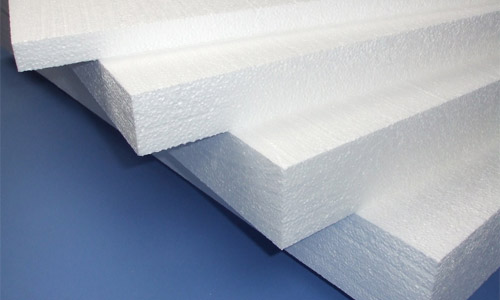
Plates of simple polystyrene can also be attributed to this type of insulation.
- See the material >> Expanded polystyrene - characteristics and selection criteria
8. Foamed polyethylene insulation.
If a foam-forming substance (one of the types of hydrocarbons) is added to polyethylene during the manufacturing process, then we will get a material with numerous small pores inside. It has good vapor barrier properties and also perfectly protects against external noise.
Properties of foamed polyethylene:
- Density - from 25 to 50 kilograms per cubic meter.
- The coefficient of thermal conductivity is from 0.044 to 0.051 watts per meter per Kelvin.
- The temperature range of application is from minus 40 to plus 100 degrees.
- Moisture absorption is low.
- Chemical and biological passivity are high.

Foamed polyethylene in rolls, often produced in a special form for pipe insulation.
9. Fiberboard.
Taking as a basis narrow and thin wood shavings, which are also called wood wool, adding cement or a magnesian component for bonding, we obtain fibrolite. It is available in the form of plates. This material is not afraid of chemical and biological aggressive influences. It protects against noise and can also be used in rooms where it is very humid. These are, for example, pools.
Characteristics of fiberboard:
- Density - from 300 to 500 kilograms per cubic meter.
- The coefficient of thermal conductivity is from 0.08 to 0.1 watts per meter per Kelvin.
- Fire resistance is high.
10. Sotoplastovy heater.
As a rule, this material consists of hexagonal cells resembling honeycombs - hence the name. However, there are types of honeycomb, where the shape of the cells is different from the hexagon. The filler is a special fabric or paper based on carbon, cellulose, organic or glass fibers coated with a film. These fibers are bonded using thermoactive resins - phenolic or epoxy. The outer sides of the honeycomb panels are thin sheets of laminate.
The characteristics of sotoplast depend on what raw material is the basis of this material. The size of the cells and the amount of resin used to bind the base play a significant role.
11. Ecowool.
This material is made from paperboard waste. Used waste remaining in the manufacture of boxes from corrugated cardboard, defective books, newspapers and magazines, waste cardboard production. It is possible to use waste paper for these purposes - only then the raw materials will be of lower quality. After all, such material will become faster to be contaminated, and it will also be different in variety and heterogeneity.
Ecowool specifications:
- Soundproofing is very high. A layer of this material of only 1.5 centimeters is capable of absorbing up to 9 decibels of extraneous noise.
- Thermal insulation ability is very high. The downside is its decline over time. Indeed, ecowool gradually loses up to one fifth of its volume.
- Moisture absorption is high. This parameter ranges from 9 to 15 percent.
- The absence of seams when laying by continuous spraying is a definite plus.

Ecowool in bulk.
- See the material >>Ecowool - technical characteristics and properties of a heater
Inorganic type heat insulators
Now consider the inorganic types of insulation and their characteristics. The following minerals are used to manufacture this type of materials: asbestos, slag, glass, rocks. The result is glass wool, mineral wool, insulated cellular concrete, foam glass, materials based on asbestos and ceramics, lightweight concrete based on expanded perlite or vermiculite. They can be made in the form of rolls, mats, plates, and also have a loose appearance. The leader in the production of mineral insulating materials, of course, is mineral wool.
1. Mineral wool.
Mineral wool has two varieties: Slag and stone. For the production of the first of them slags are used, which are formed during casting of ferrous and non-ferrous metals. Stone wool is based on rocks: limestone, diabase, dolomite, basalt and others.A urea or phenol-based component is used to bind the base. Moreover, the latter is more suitable for construction - mineral wool with this binder is less afraid of water than that which contains urea.
Characteristics of mineral wool:
- Flammability is zero. Moreover, this material is also able to counteract the spread of fire. Therefore, it can be used as a means of protection against fire.
- Sound absorption is very high. As a soundproofing, mineral wool is very practical to use.
- Chemical passivity is high.
- Hygroscopicity is low.
- Shrinkage is extremely low. Over time, the dimensions of the material practically do not change, therefore, it is possible to avoid the appearance of cold bridges.
- Vapor permeability is high. This is a minus of this insulation - when using it, it is necessary to lay a vapor barrier layer.

Attic insulated with mineral wool.
- See the material >> Technical characteristics of basalt insulation, advantages, disadvantages and scope
3. Glass wool.
This material is made from the same raw materials as ordinary glass. However, the waste from glass production is quite suitable for him. Unlike mineral wool, glass wool has thicker and longer fibers. Therefore, it is more elastic and durable. Like mineral wool, it absorbs sounds well, does not burn and is not exposed to aggressive chemicals. When heated, glass wool does not emit harmful substances.
Glass wool characteristics:
- Density (in a free state) - no more than 130 kilograms per cubic meter.
- The coefficient of thermal conductivity is from 0.03 to 0.052 watts per meter per Kelvin.
- Resistance to high temperatures - no more than 450 degrees.
- Corrosion resistance is high.
- Hygroscopicity is low.

And here is the most common glass wool.
4. Ceramic wool.
As a basis, this material has alumina, zirconium or silicon oxide. It is made by blowing or in a centrifuge. Ceramic wool is very resistant to high temperatures - more than even mineral wool. She is not afraid of chemically aggressive substances, and is also practically not deformed.
Characteristics of ceramics:
- Temperature resistance - more than 1000 degrees. When heated above 100 degrees, the material becomes an electrical insulator.
- The thermal conductivity coefficient at plus 600 degrees is from 0.13 to 0.16 watts per meter per Kelvin.
- Density - no more than 350 kilograms per cubic meter.

Ceramic wool has such a white color.
Mixed heat insulators
Mixed heaters are made from asbestos mixtures, in which mica, dolomite, perlite or diatomite are added. Also, mineral components are introduced into the material, which serve to bind the base. The feedstock has the consistency of a light dough. While it has not yet hardened, it is applied to the right place and waiting to dry. The molding products are also made from this material: plates and shells.
Such a characteristic of heaters of this type, as heat resistance, is clearly at a height. Asbestos-based insulation can easily withstand 900 degrees. True, their numerous pores absorb moisture too well, therefore, in this case, waterproofing is indispensable. Asbestos dust is dangerous for humans, especially for allergy sufferers, so strict adherence to sanitary standards when using such heaters is necessary. The following asbestos heat insulators are most often used: sovelite and volcanic. Their thermal conductivity ranges from 0.2 watts per meter to Kelvin.
Thermal insulation reflective type
Heaters, called reflex, or reflective, work on the principle of slowing down the movement of heat. After all, every building material is capable of absorbing heat and then radiating it. As you know, heat loss occurs mainly due to the exit of infrared rays from the building. They easily penetrate even materials whose thermal conductivity is low.
But there are other substances - their surface can reflect from 97 to 99 percent of the heat reaching it.This, for example, silver, gold and polished aluminum without impurities. Taking one of these materials and building a thermal barrier using a plastic film, you can get an excellent heat insulator. Not only that - it will simultaneously serve as a vapor barrier. Therefore, it is ideal for warming a bath or sauna.
The reflective insulation today is polished aluminum (one or two layers) plus foamed polyethylene (one layer). This material is thin, but giving a tangible result. So, with a thickness of such a heater from 1 to 2.5 centimeters, the effect will be the same as when using a fibrous heat insulator from 10 to 27 centimeters thick. As an example, we call Armofol, Ecofol, Porileks, Penofol.

One type of reflective thermal insulation.
So, we have listed all types of insulation and their characteristics. When choosing one of them, pay attention to the possibility of its complex application. It’s not bad if this material not only insulates your home, but also protects it from noise and wind gusts.

